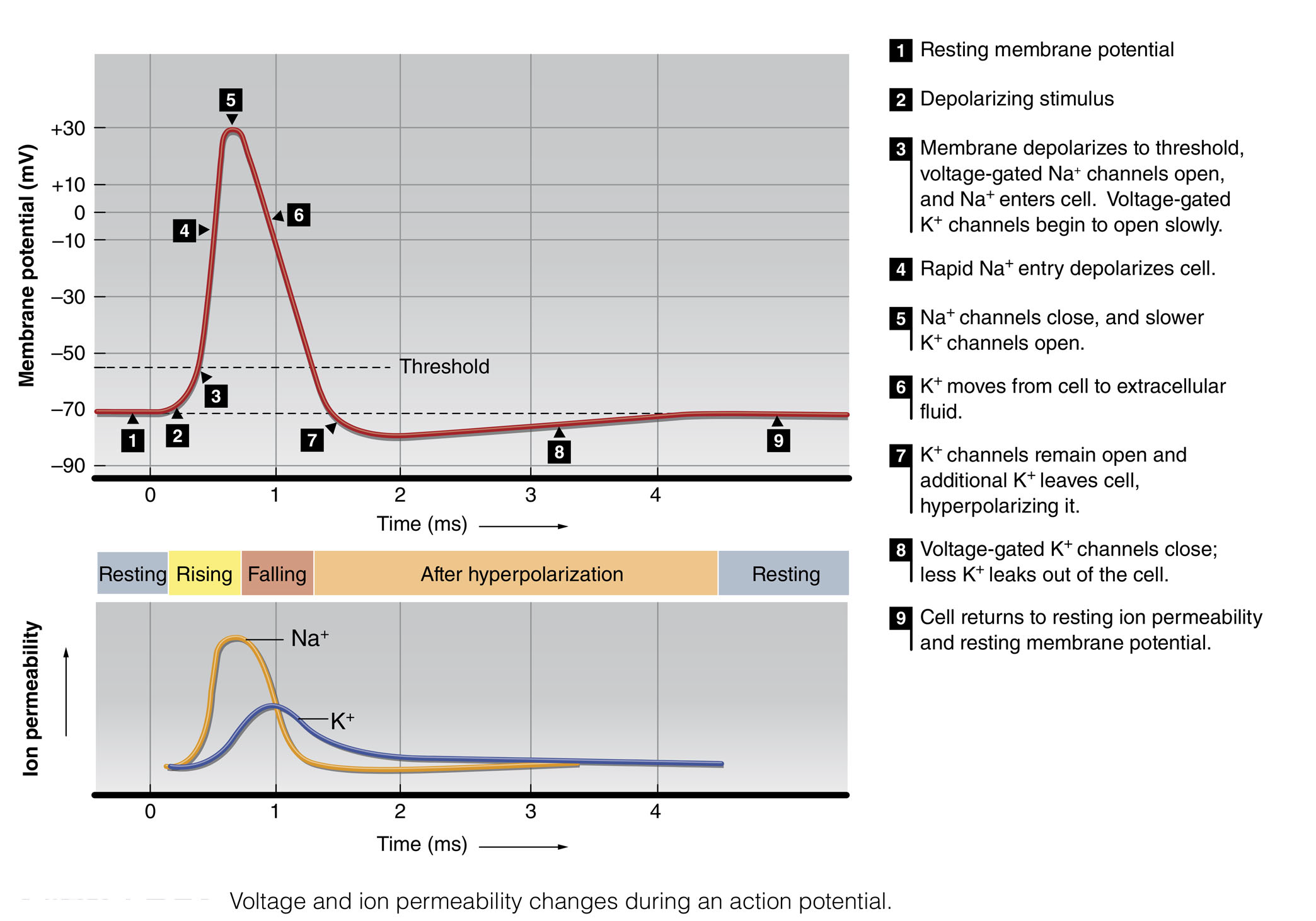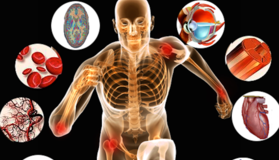Chapter 3
Neural Controlof Exercising Muscle
Structure and Function of the Nervous System
Neurons are excitable tissues because they have the ability to respond to various types of stimuli and convert them to an electrical signal or nerve impulse.
A neuron's RMP of about -70 mV results from the uncqual separation of positivcly charged sodium and poassumions, with more potassium inside the membrane and more sodium on the outside.
The RMP is maintained by actionsof the sodium- -potassium pump, coupled with low sodium permeability and highpotassium permeability of the neuron membrane.
Any change that makes the membranepotential less negative results in depolarization. Any change making thispotential more negative is a hyperpolarization. These changes occur when iongates in the membrane open, permitting more ions to move across the membrane.
If the membrane is depolarized by15 to 20 mV, the depolarization threshold is reached and a rached and an actionpotential rsults. Acion potentias are not generated if the threshold is notmet.
In myelinated neurons, the impulsetravels through the axon by jumping between nodes of Ranvier (gaps between thecells that form the myelin sheath). 'This process,saltatory conduction, resultsin nerve transmission rates 5 to 50 times faster than in unmyelinated fibers ofthe same size. Impulses also travel faster in neurons of larger diameter.

Synapses
Neurons communicate with eachother across synapses composed of the axonterminals of the presynaptic neuron,the postsynaptic receptors on the dendrite or cell body of the postsynapticneuron, and the synaptic cleft between the two neurons.
A nerve impulsecauses neurotransmitters to be released from the presynaptic axonterminal intothe synaptic cleft.
Neurotransmittersdiffuse across the cleft and bind to the postsynaptic receptors.
Once sufficientneurotransmitters are bound, the impulse is successfully transmitted and theneurotransmitter is then destroyed by enzymes, is removed by reuptake into thepresynaptic terminal for future use, or diffuses away from the synapse.
Neurotransmitterbinding at the postsynaptic receptors opens ion gates in the given membrane andcan cause depolarization (excitation) or hyperpolarization (inhibition),depending on the specific neurotransmitter and the receptors to which it binds.
Neuronscommunicate with muscle fibers at neuromuscular junctions. A neuromuscularjunction involves presynaptic axon terminals, the synaptic cleft, and motorend-plate receptors on the plasmalemma of the muscle fiber and functions muchlike a neural synapse.
Theneurotransmitters most important in regulating exercise responses are acetylcholinein the somatic nervous system and norepinephrine in the autonomic nervoussystem.
Receptors on the motorend plates of the neuromuscular junction are a special subtype of cholinergicreceptors called muscarinic receptors. They bind the primary neurotransmitterinvolved in excitation of muscle fibers, acetylcholine.
Central Nervous System
The CNS includes the brain and thespinal cord.
The four major divisions of thebrain are the cerebrum, the diencephalon, the cerebellum, and the brain stem.
The cerebral cortex is theconscious brain. The primary motor cortex, located in the frontal lobe, is thecenter of conscious motor control. .
The basal ganglia, in the cerebralwhite matter, help initiate some movements (sustained and repetitive ones) andhelp control posture and muscle tone.
The diencephalon includes thethalamus, which receives all sensory input entering the brain, and thehypothalamus, which is a major control center for homeostasis.
The cerebellum, which is connectedto numerous parts of the brain, is critical for coordinating movement. It is anintegration center that decides how to best execute the desired movement, giventhe body's current position and the muscles current status.
The brain stem is composed of themidbrain, the pons, and the medulla oblongata.
The spinal cord contains bothsensory and motor fibers that transmit action potentials between the brain andthe periphery.
Peripheral Nervous System
Sensory-motor integration is theprocess by which the PNS relays sensory input to the CNS and the CNS interpretsthis information and then sends out the appropriate motor signal to elicit thedesired motor response.
The level of nervous systemresponse to sensory input varies according to the complexity of movementnecessary. Most simple reflexes are handled by the spinal cord, whereas complexreactions and movements require activation of higher centers in the brain.
Sensory input can terminate atvarious levels of the CNS. Not all of this information reaches the brain.
Reflexes are the simplest form ofmotor control. These are not conscious responses. For a given sensory stimulus,the motor response is always identical and instantaneous.
Muscle spindles trigger reflexivemuscle action when stretched.
Golgi tendon organs trigger areflex that inhibits contraction if the tendon fibers are stretched from highmuscle tension.
In closing
In this chapter we examined howthe nervous system is organized and how that organization functions to controlmovement. We covered the central nervous system as it relates to movement andthe sensory and effector arms of the peripheral nervous system. We have seenhow muscles respond to neural stimulation, whether through reflexes or undercomplex control of the higher brain centers, and the role of individual motorunits in determining this response. Thus, we have learned how the bodyfunctions to allow people to move. In the next chapter, we examine the role ofhormones in the body's response to exercise.
Study Questions
1. What are the major divisions of the nervous system? W hat are their major functions?
2. Namethe different anatomical parts of a neuron and discuss their function.
3.Explain the resting membrane potential. What causes it? How is it maintained?
4.Describe an action potential. What is required before an action potential isactivated?
5.Explainhow an action potential is transmitted from a presynaptic neuron to apostsynaptic neuron. Describe a synapse and a neuromuscular junction.
6. What brain centers have major roles incontrolling movement, and what are theseroles?
7.How dothe sympathetic and parasympathetic systems differ? What is their significancein performing physical activity?
8.Explain how reflex movement occurs in response to touching a hot object.
9.Describe the role of the muscle spindle in controlling muscle contraction.
10.Describe the role of the Golgi tendon organ in controlling muscle contraction.


